
A | B | C | D | E | F | G | H | CH | I | J | K | L | M | N | O | P | Q | R | S | T | U | V | W | X | Y | Z | 0 | 1 | 2 | 3 | 4 | 5 | 6 | 7 | 8 | 9



This list of space telescopes (astronomical space observatories) is grouped by major frequency ranges: gamma ray, x-ray, ultraviolet, visible, infrared, microwave, and radio. Telescopes that work in multiple frequency bands are included in all of the appropriate sections. Space telescopes that collect particles, such as cosmic ray nuclei and/or electrons, as well as instruments that aim to detect gravitational waves, are also listed. Missions with specific targets within the Solar System (e.g., the Sun and its planets), are excluded; see List of Solar System probes for these, and List of Earth observation satellites for missions targeting Earth.
Two values are provided for the dimensions of the initial orbit. For telescopes in Earth orbit, the minimum and maximum altitude are given in kilometers. For telescopes in solar orbit, the minimum distance (periapsis) and the maximum distance (apoapsis) between the telescope and the center of mass of the Sun are given in astronomical units (AU).
Gamma ray
Gamma-ray telescopes collect and measure individual, high energy gamma rays from astrophysical sources. These are absorbed by the atmosphere, requiring that observations are done by high-altitude balloons or space missions. Gamma rays can be generated by supernovae, neutron stars, pulsars and black holes. Gamma ray bursts, with extremely high energies, have also been detected but have yet to be identified.[1]
| Photo | Name | Space agency | Launch date | Terminated | Location | Ref(s) |
|---|---|---|---|---|---|---|
 |
Proton-1 | USSR | 16 Jul 1965 | 11 Oct 1965 | Earth orbit (183-589 km) | [2] |
 |
Proton-2 | USSR | 2 Nov 1965 | 6 Feb 1966 | Earth orbit (191-637 km) | [2] |
 |
Proton-4 | USSR | 16 Nov 1968 | 24 Jul 1969 | Earth orbit (248-477 km) | [3] |
 |
Small Astronomy Satellite 2 (SAS-B) | NASA | 15 Nov 1972 | 8 Jun 1973 | Earth orbit (443–632 km) | [4][5] |
 |
Cos-B | ESA | 9 Aug 1975 | 25 Apr 1982 | Earth orbit (339.6–99,876 km) | [6][7][8] |
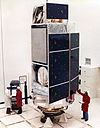 |
High Energy Astronomy Observatory 3 | NASA | 20 Sep 1979 | 29 May 1981 | Earth orbit (486.4–504.9 km) | [9][10][11] |
 |
Granat | CNRS & IKI | 1 Dec 1989 | 25 May 1999 | Earth orbit (2,000–200,000 km) | [12][13][14] |
 |
Gamma | USSR, CNES, RSA | 11 Jul 1990 | 1992 | Earth orbit (375 km) | [15] |
 |
Compton Gamma Ray Observatory (CGRO) | NASA | 5 Apr 1991 | 4 Jun 2000 | Earth orbit (362–457 km) | [16][17][18] |
| Low Energy Gamma Ray Imager (LEGRI) | INTA | 19 May 1997 | Feb 2002 | Earth orbit (600 km) | [19][20] | |
 |
High Energy Transient Explorer 2 (HETE 2) | NASA | 9 Oct 2000 | Mar 2008 | Earth orbit (590–650 km) | [21][22][23] |
| International Gamma Ray Astrophysics Laboratory (INTEGRAL) | ESA | 17 Oct 2002 | — | Earth orbit (639–153,000 km) | [24][25] | |
 |
Neil Gehrels Swift Observatory | NASA | 20 Nov 2004 | — | Earth orbit (585–604 km) | [26][27] |
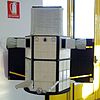 |
Astrorivelatore Gamma ad Immagini Leggero (AGILE) | ISA | 23 Apr 2007 | 18 Jan 2024 | Earth orbit (524–553 km) | [28][29] |
| Fermi Gamma-ray Space Telescope | NASA | 11 Jun 2008 | — | Earth orbit (555 km) | [30] | |
 |
Gamma-Ray Burst Polarimeter (IKAROS) | JAXA | 21 May 2010 | 21 May 2015 | Heliocentric orbit | [31][32] |
X-ray
X-ray telescopes measure high-energy photons called X-rays. These can not travel a long distance through the atmosphere, meaning that they can only be observed high in the atmosphere or in space. Several types of astrophysical objects emit X-rays, from galaxy clusters, through black holes in active galactic nuclei to galactic objects such as supernova remnants, stars, and binary stars containing a white dwarf (cataclysmic variable stars), neutron star or black hole (X-ray binaries). Some Solar System bodies emit X-rays, the most notable being the Moon, although most of the X-ray brightness of the Moon arises from reflected solar X-rays. A combination of many unresolved X-ray sources is thought to produce the observed X-ray background.
| Photo | Name | Space agency | Launch date | Terminated | Location | Ref(s) |
|---|---|---|---|---|---|---|
 |
Uhuru (Small Astronomy Satellite 1, SAS-A) | NASA | 12 Dec 1970 | Mar 1973 | Earth orbit (531–572 km) | [33][34][35] |
 |
Astronomical Netherlands Satellite (ANS) | SRON | 30 Aug 1974 | Jun 1976 | Earth orbit (266–1176 km) | [36][37] |
 |
Ariel V | SRC & NASA | 15 Oct 1974 | 14 Mar 1980 | Earth orbit (520 km) | [38][39] |
 |
Aryabhata | ISRO | 19 Apr 1975 | 23 Apr 1975 | Earth orbit (563–619 km) | [40] |
 |
Small Astronomy Satellite 3 (SAS-C) | NASA | 7 May 1975 | Apr 1979 | Earth orbit (509–516 km) | [41][42][43] |
 |
Cos-B | ESA | 9 Aug 1975 | 25 Apr 1982 | Earth orbit (339.6–99,876 km) | [6][7][8] |
| Cosmic Radiation Satellite (CORSA) | ISAS | 4 Feb 1976 | 4 Feb 1976 | Failed launch | [44][45] | |
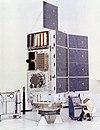 |
High Energy Astronomy Observatory 1 (HEAO 1) | NASA | 12 Aug 1977 | 9 Jan 1979 | Earth orbit (445 km) | [46][47][48] |
 |
Einstein Observatory (HEAO 2) | NASA | 13 Nov 1978 | 26 Apr 1981 | Earth orbit (465–476 km) | [49][50] |
 |
Hakucho (CORSA-b) | ISAS | 21 Feb 1979 | 16 Apr 1985 | Earth orbit (421–433 km) | [51][52][53] |
 |
High Energy Astronomy Observatory 3 (HEAO 3) | NASA | 20 Sep 1979 | 29 May 1981 | Earth orbit (486.4–504.9 km) | [9][10][11] |
 |
Tenma (Astro-B) | ISAS | 20 Feb 1983 | 19 Jan 1989 | Earth orbit (489–503 km) | [54][55][56] |
 |
Astron | IKI | 23 Mar 1983 | Jun 1989 | Earth orbit (2,000–200,000 km) | [57][58][59] |
 |
EXOSAT | ESA | 26 May 1983 | 8 Apr 1986 | Earth orbit (347–191,709 km) | [60][61][62] |
 |
Ginga (Astro-C) | ISAS | 5 Feb 1987 | 1 Nov 1991 | Earth orbit (517–708 km) | [63][64][65] |
 |
Granat | CNRS & IKI | 1 Dec 1989 | 25 May 1999 | Earth orbit (2,000–200,000 km) | [12][13][14] |
| ROSAT | NASA & DLR | 1 Jun 1990 | 12 Feb 1999 | Re-entry 23 October 2011.[66] Formerly Earth orbit (580 km) |
[67][68][69] | |
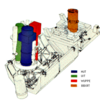 |
Broad Band X-ray Telescope / Astro 1 | NASA | 2 Dec 1990 | 11 Dec 1990 | Earth orbit (500 km) | [70][71] |
 |
Advanced Satellite for Cosmology and Astrophysics (ASCA, Astro-D) | ISAS & NASA | 20 Feb 1993 | 2 Mar 2001 | Earth orbit (523.6–615.3 km) | [72][73] |
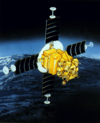 |
Array of Low Energy X-ray Imaging Sensors (Alexis) | LANL | 25 Apr 1993 | 2005 | Earth orbit (749–844 km) | [74][75][76] |
 |
Rossi X-ray Timing Explorer (RXTE) | NASA | 30 Dec 1995 | 3 Jan 2012 | Earth orbit (409 km) | [77][78][79] |
 |
BeppoSAX | ASI | 30 Apr 1996 | 30 Apr 2002 | Earth orbit (575–594 km) | [80][81][82] |
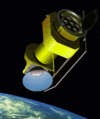 |
A Broadband Imaging X-ray All-sky Survey (ABRIXAS) | DLR | 28 Apr 1999 | 1 Jul 1999 | Earth orbit (549–598 km) | [83][84][85] |
 |
Chandra X-ray Observatory | NASA | 23 Jul 1999 | — | Earth orbit (9,942–140,000 km) | [86][87] |
| XMM-Newton | ESA | 10 Dec 1999 | — | Earth orbit (7,365–114,000 km) | [88][89] | |
 |
High Energy Transient Explorer 2 (HETE 2) | NASA | 9 Oct 2000 | Mar 2008 | Earth orbit (590–650 km) | [21][22][90] |
| International Gamma Ray Astrophysics Laboratory (INTEGRAL) | ESA | 17 Oct 2002 | — | Earth orbit (639–153,000 km) | [24][25] | |
 |
Neil Gehrels Swift Observatory | NASA | 20 Nov 2004 | — | Earth orbit (585–604 km) | [26][27] |
 |
Suzaku (Astro-E2) | JAXA & NASA | 10 Jul 2005 | 2 Sep 2015 | Earth orbit (550 km) | [91][92] |
 |
Astrorivelatore Gamma ad Immagini Leggero (AGILE) | ISA | 23 Apr 2007 | 18 Jan 2024 | Earth orbit (524–553 km) | [28][29] |
 |
Nuclear Spectroscopic Telescope Array (NuSTAR) | NASA | 13 Jun 2012 | — | Earth orbit (603.5 km) | [93][94] |
 |
AstroSat | ISRO | 28 Sep 2015 | — | Earth orbit (600–650 km) | [95][96][97] |
 |
Hitomi (Astro-H) | JAXA | 17 Feb 2016 | 28 Apr 2016 | Earth orbit (575 km) | [98][99][100] |
 |
Mikhailo Lomonosov | Moscow State University | 28 Apr 2016 | 30 Jun 2018 | Earth orbit (478–493 km) | [101][102] |
 |
Neutron Star Interior Composition Explorer (NICER) | NASA | 7 Jun 2017 | — | International Space Station | [103] |
 |
Hard X-ray Modulation Telescope (HXMT) | CNSA & CAS | 14 Jun 2017 | — | Low Earth orbit (545–554.1 km) | [104] |
 |
Spektr-RG | RSRI & MPE | Jul 13, 2019 | — | Sun-Earth L2 | [105] |
 |
Imaging X-ray Polarimetry Explorer (IXPE) | NASA | 9 Dec 2021 | — | Earth orbit (540 km) | [106][107] |
| Lobster Eye Imager for Astronomy (LEIA) | CSA | 27 Jul 2022 | — | Low Earth orbit | [108][109] | |
 |
X-ray Imaging and Spectroscopy Mission (XRISM) | JAXA & NASA | 7 Sep 2023 | — | Earth orbit (550 km) | [110][111] |
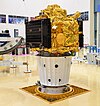 |
X-ray Polarimeter Satellite (XPoSat) | ISRO & RRI | 1 Jan 2024 | — | Earth orbit (638–653 km) | [112][113] |
| Einstein Probe | CAS & ESA & MPE | 9 Jan 2024 | — | Earth orbit (581–593 km) | [114] |
Ultraviolet
Ultraviolet telescopes make observations at ultraviolet wavelengths, i.e. between approximately 10 and 320 nm. Light at these wavelengths is absorbed by the Earth's atmosphere, so observations at these wavelengths must be performed from the upper atmosphere or from space.[115] Objects emitting ultraviolet radiation include the Sun, other stars and galaxies.[116]
| Photo | Name | Space agency | Launch date | Terminated | Observing location | Ref(s) |
|---|---|---|---|---|---|---|
 |
OAO-2 (Stargazer) | NASA | 7 Dec 1968 | Jan 1973 | Earth orbit (749–758 km) | [117][118] |
| Orion 1 and Orion 2 Space Observatories | USSR | 19 Apr 1971 (Orion 1); (Orion 2) 18 Dec 1973 | 1971; 1973 | Earth orbit (Orion 1: 200–222 km; Orion 2: 188–247 km) | [119][120] | |
 |
Far Ultraviolet Camera/Spectrograph (UVC) | NASA | 16 Apr 1972 | 23 Apr 1972 | Descartes Highlands on lunar surface | [121] |
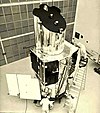 |
OAO-3 Copernicus | NASA | 21 Aug 1972 | Feb 1981 | Earth orbit (713–724 km) | [117] |
 |
Astronomical Netherlands Satellite (ANS) | SRON | 30 Aug 1974 | Jun 1976 | Earth orbit (266–1176 km) | [36][37] |
 |
International Ultraviolet Explorer (IUE) | ESA & NASA & SERC | 26 Jan 1978 | 30 Sep 1996 | Earth orbit (32,050–52,254 km) | [122][123] |
 |
Astron | IKI | 23 Mar 1983 | Jun 1989 | Earth orbit (2,000–200,000 km) | [57][58][59] |
 |
Hubble Space Telescope | NASA & ESA | 24 Apr 1990 | — | Earth orbit (586–610 km) | [124] |
 |
Broad Band X-ray Telescope / Astro 1 | NASA | 2 Dec 1990 | 11 Dec 1990 | Earth orbit (500 km) | [70][71] |
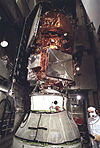 |
Extreme Ultraviolet Explorer (EUVE) | NASA | 7 Jun 1992 | 31 Jan 2001 | Earth orbit (515–527 km) | [125][126] |
 |
Astro 2 | NASA | 2 Mar 1993 | 18 Mar 1993 | Earth orbit (349–363 km) | [127][128] |
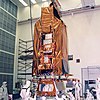 |
Far Ultraviolet Spectroscopic Explorer (FUSE) | NASA & CNES & CSA | 24 Jun 1999 | 12 Jul 2007 | Earth orbit (752–767 km) | [129][130] |
 |
Cosmic Hot Interstellar Spectrometer (CHIPS) | NASA | 13 Jan 2003 | 11 Apr 2008 | Earth orbit (578–594 km) | [131][132] |
 |
Galaxy Evolution Explorer (GALEX) | NASA | 28 Apr 2003 | 28 Jun 2013 | Earth orbit (691–697 km) | .[133][134][135] |
| Korea Advanced Institute of Science and Technology Satellite 4 (Kaistsat 4) | KARI | Zdroj:https://en.wikipedia.org?pojem=List_of_space_telescopes
